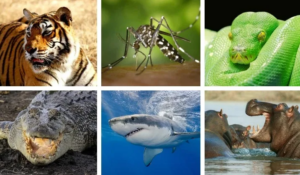The animal kingdom is home to a vast array of creatures, each with unique characteristics and behaviors. While many animals pose no threat to humans, some have earned a fearsome reputation as the most dangerous animals on Earth. In this article, we will explore the top contenders for this notorious title, delving into the fascinating world of dangerous animals such as venomous snakes, powerful predators, and microscopic menaces.

The Box Jellyfish
With its translucent body and delicate appearance, the box jellyfish may not seem like a fearsome creature. However, lurking beneath its gelatinous exterior is a potent venom that makes it one of the most venomous animals in the world. Encounters with box jellyfish can result in excruciating pain, paralysis, and, in severe cases, death.
Saltwater Crocodile
Known as the “salty” by locals, the saltwater crocodile is the largest living reptile and a true apex predator. These massive reptiles inhabit the brackish waters of mangroves and estuaries, patiently waiting for prey to approach. With their powerful jaws and lightning-fast strikes, saltwater crocodiles are responsible for fatal attacks on humans who venture too close to their territory.
African Elephant
The African elephant, the world’s largest land mammal, is admired for its intelligence and social behavior. However, these gentle giants can become highly aggressive when provoked. Responsible for more human deaths in Africa than any other large animal, African elephants serve as a reminder of the wild’s unpredictable nature.
Cape Buffalo
Cape buffaloes may appear docile when grazing on the African savannah, but they are unpredictable and extremely dangerous when threatened. Their formidable build and sharp, curved horns make them a force to be reckoned with. Capable of running at high speeds, these bovines are responsible for deadly attacks, especially when cornered.
Inland Taipan
The inland taipan, also known as the “fierce snake” or “small-scaled snake,” is native to Australia and boasts the title of the world’s most venomous snake. Fortunately, this elusive serpent is rarely encountered by humans, and its venomous bite is lethal if not promptly treated.
Mosquito
Despite its minuscule size, the mosquito is one of the deadliest creatures on Earth. This tiny insect is a vector for diseases such as malaria, dengue fever, and the Zika virus, causing millions of human fatalities each year. Its inconspicuous presence conceals its capacity to wreak havoc on a global scale.
Saltwater Crocodile
Known as the “salty” by locals, the saltwater crocodile is the largest living reptile and a true apex predator. These massive reptiles inhabit the brackish waters of mangroves and estuaries, patiently waiting for prey to approach. With their powerful jaws and lightning-fast strikes, saltwater crocodiles are responsible for fatal attacks on humans who venture too close to their territory.
African Elephant
The African elephant, the world’s largest land mammal, is admired for its intelligence and social behavior. However, these gentle giants can become highly aggressive when provoked. Responsible for more human deaths in Africa than any other large animal, African elephants serve as a reminder of the wild’s unpredictable nature.
Cape Buffalo
Cape buffaloes may appear docile when grazing on the African savannah, but they are unpredictable and extremely dangerous when threatened. Their formidable build and sharp, curved horns make them a force to be reckoned with. Capable of running at high speeds, these bovines are responsible for deadly attacks, especially when cornered.
Inland Taipan
The inland taipan, also known as the “fierce snake” or “small-scaled snake,” is native to Australia and boasts the title of the world’s most venomous snake. Fortunately, this elusive serpent is rarely encountered by humans, and its venomous bite is lethal if not promptly treated.
Conclusion
The natural world is home to a multitude of creatures, some of which can be deadly to humans. From venomous marine life to formidable predators on land, these dangerous animals serve as a reminder of the importance of respecting and understanding the diverse ecosystems they inhabit. While encounters with these creatures are rare, it’s essential to appreciate their place in the intricate web of life on our planet.
